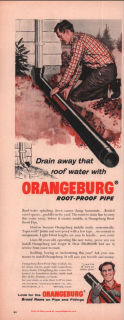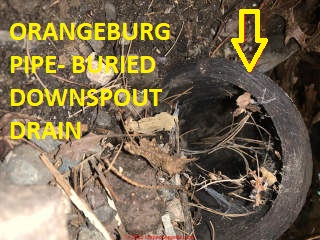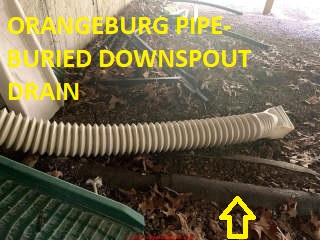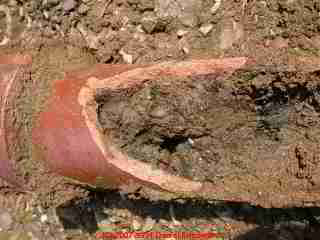 Orangeburg Pipe
Orangeburg Pipe
Identification, properties, history, uses
- POST a QUESTION or COMMENT about orangeburg pipe sewer & drain piping
Orangeburg pipe used in drainage & septic systems:
Orangeburg pipe is black, not orange, and is fragile after spending decades buried underground. Here we describe the composition, history, and uses of orangeburg pipe.
This article defines and describes different types of building supply and drain piping with an alphabetical list of piping materials and properties.
InspectAPedia tolerates no conflicts of interest. We have no relationship with advertisers, products, or services discussed at this website.
Orangeburg Pipes at buildings: definition, properties
 Orangeburg pipes, named not for their color but for the town(Orangeburg NY) where the Fibre Conduit Company, a major pipe manufacturer was located, were used outside buildings to connect the building drain to septic systems or in some areas to sewer pipes.
Orangeburg pipes, named not for their color but for the town(Orangeburg NY) where the Fibre Conduit Company, a major pipe manufacturer was located, were used outside buildings to connect the building drain to septic systems or in some areas to sewer pipes.
In North America Orangeburg pipe was used in both municipal water supply piping systems and in both public sewer systems and in private septic systems as well as other site drainage systems from the 1860s to as late as the late 1970s.
Orangeburg pipes are black, and somewhat fragile bituminous-coated fiber pipes.
[Click to enarge any image]
OPINION: think Orangeburg pipe? think "tar impregnated cardboard". Inexpensive, widely used.
Orangeburg piping was used in both un-perforated form as septic distribution piping and more widely in perforated form as effluent distribution piping in septic drainfields and as buried downspout drain lines.
As we explain
at AGE of PLUMBING MATERIALS & FIXTURES,
Orangeburg drain & septic field piping, most widely used in drain piping and septic fields, was made of multiple layers of ground wood fibers bound with an adhesive mastic (coal tar), impregnated with coal tar pitch, and typically looking like black"tarred" piping.
Older orangeburg pipe will often be delaminating and may have broken or collapsed.
Orangeburg piping was first used in Boston in 1865.
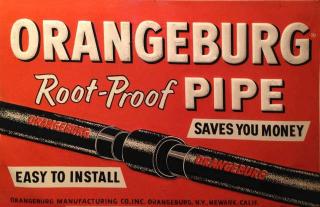 Despite it's name, "Orangeburg pipe" is not orange in color and it never was, though if you want to see some orange-colored sewer piping see our description of Terra Cotta (clay) pipes below in this article.
Despite it's name, "Orangeburg pipe" is not orange in color and it never was, though if you want to see some orange-colored sewer piping see our description of Terra Cotta (clay) pipes below in this article.
The name Orangeburg pipe comes from the main producer of this product, the Fibre Conduit Co., in Orangeburg, New York. By the time the sign advertising "Orangeburg root-proof pipe" was produced the company also had facilities in Newark California.
The Fibre Conduit Company was founded by Stephen Bradley (owner of electric lighting and power companies) in Orangeburg NY in 1893.
In its earliest production the steam waste exhaust from early steam-generated electrical power plants was used in the manufacture of orangeburg pipe to heat and dry it.
Later orangeburg pipe was also used as five-foot sections of electrical wire conduit, probably a successor to the much heavier and more costly tar-filled pipes that carried Edison's earliest Solid Iron Tubing or Steel Pipe & Pitch Insulated Electrical Cables.
An advantage of asphalt-based conduit piping was its resistance to corrosion and acids.
The 1939 Worlds' Fair advertisement described wide use of Orangeburg pipe by that year. [Advertisement shown below]
Orangeburg pipe was sold for underground ductwork use with a concrete encasement as well as an Orangeburg "Nocrete" version was used for electrical service entrances and similar applications.
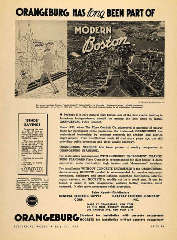 By the late 1930's to early 1940's this wood-fibre-based conduit or piping was marketed under the brand Alkacid. Later Alkacid and other brands of fibre-based asphalt impregnated pipe were replced by asbestos-cement pipe or transite pipe.
By the late 1930's to early 1940's this wood-fibre-based conduit or piping was marketed under the brand Alkacid. Later Alkacid and other brands of fibre-based asphalt impregnated pipe were replced by asbestos-cement pipe or transite pipe.
You can see my photo of a section of that earlier electrical cabling
at STEAM BOILERS GENERATORS CONTROLS, PRATT
After 1948 the originator of orangeburg pipe, the Fibre Conduit company changed its name to Orangeburg Manufacturing.
Black coal-tar impregnated fiber piping was widely used in North American from 1950 to 1970.
List of Manufacturers of Orangeburg Pipe
Orangeburg drain piping and sewer piping was not made just by Fiber Conduit.
- American Manufacturing
- American Piping Co.,
- Bermico (Brown Manufacturing) [advertisement shown below]
- Fibre Conduit Co.
- J.M. Fiber Conduit Co. (Orangeburg NY)
- Orangeburge Manufacturing
Life Expectancy of an Orangeburg Pipe Drainfield
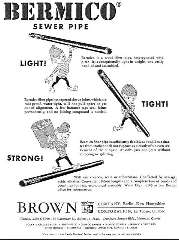 We estimate by the late 1940's, and continuing through the 1960's perforated Orangeburg pipe was widely used in the U.S. and parts of Canada for area drains and particularly as distribution piping in septic drainfields.
We estimate by the late 1940's, and continuing through the 1960's perforated Orangeburg pipe was widely used in the U.S. and parts of Canada for area drains and particularly as distribution piping in septic drainfields.
We still come across Orangeburg pipe when excavating old septic drainfields and on occasion when inspecting an older home, say before 1970, you may see the top of a section of Orangeburg pipe peeking up above ground as a connection for a roof gutter downspout.
In our Orangeburg pipe downspout drain photo above on this page we were pointing out (the pen) that perforated pipe was used as a buried drain right next to the building - inviting basement water entry even if the drain is not yet clogged.
And figure, if you see a buried downspout drain using a material not commonly installed for 40 years, that the drain itself may be blocked or collapsed by now.
Watch out: What about a septic drainfield built using Orangeburg pipe?
Orangeburg pipe was less rigid than terra-cotta piping (though also less fragile), making it vulnerable to both crushing-collapse and tree-root invasion. In fact some of our research sources cited root invasion as the most common mode of orangeburg pipe failure, though with age, collapse is also common.
If you encounter a septic absorption bed or drainfield that used Orangeburg pipe you should not count on the continued usability of that septic system. Such a drainfield is by now likely to be in questionable, if not failed condition.
Orangeburg Pipe Dimensions: diameters & wall thickness
Orangeburg pipe was manufactured in a variety of diameters and thicknesses for various applications including electrical conduit and sewer or drainfield effluent distribution pipes. Orangeburg common diameters ranged from 3" to 8" I.D.
Orangeburg pipe used as perforated septic drainfield piping had a nominal ID of 4.00 inches and an O.D. that varied by manufacturer; the pipe wall was about 3/16" to 1/4" thick.
Orangeburg with a 4.0" ID and that's 3/16" thick would have an OD of about 4.375"
Orangeburg pipe lengths varied but it was often sold in 10 ft. lengths.
Orangeburg Pipe Patent History
- BIKLEN, Donald W. Bituminized fiber pipe. U.S. Patent No 2,839,088, 17 Jun. 1958.
- BRADLEY JR, Stephen R. Machine for making pulp pipes. U.S. Patent No 799,028, [PDF] 9 12 Sept. 1905.
- BRADLEY, Stephen R. Process of manufacturing pulp pipe. U.S. Patent No 966,729, [PDF] 9 Ago. 1910. Assignee: Fibre Conduit Co., Orangeburg New York. [The company later changed its name to the Orangeburg Pipe Co. - Ed.]
- BULLOCK, P.; MILFORD, M. H.; CLINE, M. G. Degradation of Argillic Horizons in Udalf Soils of New York State 1. Soil Science Society of America Journal, 1974, vol. 38, no 4, p. 621-628.
Excerpt: Lengths of Orangeburg pipe were prepared which were 10 cm in diameter, and perforated at 5-cm intervals with four holes 1.5 cm in diameter and arranged 80 to 100° apart around the pipe. - Ellis, Benhamin F., Construction of tubes and cylinders, US Patent No 6l2,897. Patented Oct. 25, 1898. B. F. ELLIS.
Illustration: from the Ellis patent cited just above. [Click to enlarge any image]
- Fairbanks, Henry, Machine for making pulp pipes and pulp-covered rolls, US Patent 583398, [PDF] June 8, 1897, filed August 14 1893, SN 483,080.
Excerpt:
Be it known that, I, HENRY FAIRBANKS, of St. Johnsbury, in the county of Caledonia, and State of Vermont, have invented certain new and useful Improvements in Machines for Making Pulp Pipe and Pulp - Covered Rolls, of which the following, taken in con-p nection with the accompanying drawings, is a specification.
My improvement relates to machines by which rolls are covered with wood or paper pulp by winding successive layers of the soft film upon them, which covering may be dried upon the roll or loosened and slid off to be used as tubing. In order that the pulp-layer may be laid evenly upon the forming-roll A, it is necessary that this roll be held against the pulp-bearing surface with a uniform yielding pressure and follow its motion without jar.
Evidently it is a disadvantage if a heavy frame carrying the forming-roll must be moved with this roll to secure constant contact. To correct this, my improved machine has the re volving frame arranged simply to guide the motion of each forming-roll while receiving its layers of pulp, and provides a separate de vice for pressing it against the moving sur face Supplying pulp. - GANNON, Charles R. Pitch-impregnated fiber pipe. U.S. Patent No 3,927,696, 23 Dic. 1975.
- JENKINS, Charles F. Common causes of material degradation in buried piping. Westinghouse Savannah River Co., Aiken, SC (United States), 1997.
Excerpt:
... backfill plays a larger role in mechanical capability of the pipe system than it does for most other materials. Orangeburg pipe 1 frequently fails by root intrusion at joints - Kirkland, William, IMPROVED DRAN AND WATER PIPES, US Patent No. 76,778, [PDF] April 14, 1868
Excerpt:
Be it known that I, WILLIAMP. KERKLAND, of the city and county of San Francisco, State of California, have invented an Improved Drain and Water lipe; and I do hereby de clare that the materials used, and the manner of mixing and preparing the same to manu facture the said pipe, with the best apparatus lknown to me for the purpose, are described in the following specification.
The nature of my invention is to provide an improved drain and Water pipe combining strength with durability and cheapness. To accomplish this object, I employ a series of strands or cords loosely twisted, and place them in a tank or caldron of boiling asplial tum or pitcly substance, an rolnfine ti ir ends to a cylinder or roller suspended over the tank. These cords or strands are so at tached to the cylinder or form that in turn ing they will cross each other diagonally.
Between each coil of rope I place a layer of oakum or hemp, and when a desired number of coils or layers has been wound upon the l'Oller it is withdrawn, and the pipe is coated With the contents of the tank above described.
To more fully illustrate and describe my in Vention, I employ a tank or caldron, in which is placed a pitchy substance, (I prefer asphal tum after the oil has been extracted, butcom mon pitch from trees or resin might answer,) which should be well mixed by boiling, and kept heated. In this I place a series of strands, loosely twisted, or cords in two sets, so ar. anged as to be easily withdrawn from the tank, which may be accomplished, after they are attached to the cylinder, by confining their ends to a strip of paper or cloth.
After the form has been turned completely around once commence to place a layer of oakum or hemp at right angles to the Strands, turning the cylinder until a pipe of suitable thickness and trengtli is obtained, when the form is re moved, and the pipe so formed is dipped in the pitch or asphaltum in the tank, above de scribed, which coats it completely inside and out, this forming a pipe of asphaltun ol' pitch. and fibrous material without iron or other form. - Schladweiler, Jon C., P.E., R.L.S.; Historian, AZ Water, "Coal Tar Impregnated Wood Fibre Pipe (Commonly referred to as “Orangeburg,” “Bermico,” etc. pipe)", retrieved 2018/05/25, original source: http://www.sewerhistory.org/articles/compon/orangeburg/orangeburg.htm
- Schladweiler, Jon C., Tracking down the roots of our sanitary sewers. Proceedings of the Water Environment Federation, 2001, vol. 2001, no 2, p. 1-27
Excerpt:
[Orangeburg pipe] came in sizes from 3” to 8” internal diameter. The couplings were pure compression; no gaskets. The pipe manufacturer changed its name to Orangeburg Pipe ... - STANLEY, William E.; ELLIS, Robert D. Paper Pulp Wastes Treatment: Orangeburg Manufacturing Co. Sewage and Industrial Wastes, [Image file of journal article page] 1954, p. 991-1001.
Excerpts:
Orangeburg sewer pipe and Orange burg electrical conduit have been man ufactured at the present factory loca tion since 1893. The product is a hard coal-tar pitch compound reinforced with a preformed wood fiber structgure, about 75 percent hard coal-tar pitch and 25 percent wood fiber. The raw materials include coal-tar pitch, selected clean waste paper, and mineral fiber. - WOLF, Harold W. Resistance of bituminous fiber pipe to penetration by rats. Public Health Reports, 1962, vol. 77, no 9, p. 806.
Excerpt:
(1) Orangeburg root-proof or perforated pipe and fittings. Catalogue No. 307. Orangeburg Man ufacturing Co., Inc.
Reader Comments, Questions & Answers About The Article Above
Below you will find questions and answers previously posted on this page at its page bottom reader comment box.
Reader Q&A - also see RECOMMENDED ARTICLES & FAQs
Illustration: an Orangeburg "Root-Proof" pipe advertisement ca 1955.
On 2020-09-09 - by (mod) -
JD
Thanks for the helpful Orangeburg pipe question: Yes, Orangeburg was used in some municipal water supply lines as early as the 1860s and remained in widespread use in North America up to the 1970s. We've seen photos of street excavation with Orangeburg pipe fragments.
For water supply piping Orangeburg was replaced most-often with white (or green) PVC (polyvinyl chloride plastic) water supply pipes while Orangeburg pipe used in drain systems and septic systems was usually replaced with black ABS (acrylonitrile butadiene styrene) pipe.
On 2020-09-03 by JDStavely
Was there ever any Orangeburg pipe manufactured as water SUPPLY line?
On 2020-08-03 by Ellen Rollings
Thanks so much! I’d be hesitant to try and remove it as it’s at least half below grade...any value in going over it with some already paint just to seal any potential compromised areas?
On 2020-08-03 - by (mod) -
Yes. Or if you can pick up the pieces intact, without creating a mess, the old pipe can be disposed-of as construction debris.
On 2020-08-03 by Ellen Rollings
Thank you! It’s actually weirdly semi-buried, as you can see in this photo (the black pipe near the new downspout extender I installed)...it seems to be in good condition and is under the deck so it’s a low traffic area. Would you suggest just leaving it alone?
Above: Ellen's photo of the end view of a segment of Orangeburg pipe shows the black asphalt-impregnated layers of wood-based material of which Orangeburg pipe is comprised.
On 2020-08-03 - by (mod) -
It may contain asbestos but as it is buried, there is no measurable airborne asbestos hazard.
On 2020-08-02 by Ellen Rollings
One of my downspouts was feeding into this pipe. House was built in 1959. I’m guessing it’s some type of Orangeburg pipe? And I’ve read mixed opinions on whether an Orangeburg pipe fo this age could contain asbestos...any insights would be most appreciated. Thanks!
On 2020-05-07 - by (mod) - Orangeburg pipe dimensions: diameters & lengths
I'm sorry but without more information any guesses likely to be wrong. In fact ceramic sewer lines (which are not Orangeburg) were sold in varying lengths.
Orangeburg pipe - discussed on this page - is NOT a ceramic product but is bituminous, made of wood fibre and asphalt. Orangeburg sewer piping had a nominal inside diameter or I.D. of 4.00" and an outside diameter or O.D. of about 4 1/2".
Orangeburg Pipe Inside Diameter:
2" to 18" depending on use
Orangeburg Pipe Outside Diameter:
Orangeburg pipe walls were roughly 3/16" to 1/4" thick, possibly thicker for the larger diameter versions.
It sounds like you're describing an Old Bell and hub system that used what's properly named "Mission Band-Seal Vitrified Clay Pipe" - this is not Orangeburg, though the color of vitrified clay pipe is, indeed, orange or orange-brown.
Ceramic or clay sewer or drain line pipes were usually shorter in length, typically 4 ft. or 6 ft. long with a nominal ID of 4,6,8 or 10 inches.
My suggestion is to excavate a long one length and then you will know the standard length at least in that area.
Clay drainfield piping (not Orangeburg pipe) or "drain tiles" shown in our photo below is discussed in our article on sewer line replacement,
at DETERMINE NEED for DRAIN LINE REPLACEMENT.
On 2020-05-06 by James Moyles
I am repairing root intrusion at the joints of 4" sewer pipe that is older than orangeburg.
It's quite stout thick ceramic pipe.
The pieces of pipe (so far)seem fine.
The roots are just starting to come in at the joints.
I've been digging them up at the joints and cleaning there.
My main question is, do you know how long generally the pieces of pipe are.
If I knew that it will save me quite a lot of unnecessary digging.
Thanks, Jim
650-366-3629
On 2019-07-22 - by (mod) -
Terra cotta, orangeburg, vitreous clay,
On 2019-07-21 by David
What types of piping were used in drain feels prior to 1963
On 2019-07-19 - by (mod) -
Thanks for the excellent Orangeburg pipe questions, Phil.
To have space for a detailed reply I repeat your question and answer it in the article above- you may need to clear or refresh your browser cache to see the updated page.
On 2019-07-19 by MR. PHIL
1. What are the inside and outside diameters of 4" ORANGEBURG PIPE (sewage application) ?
2. What is the pipe wall dimensions of 4" orangeburg pipe?
3. Is there a BRAND NAME company that makes a re-liner insertable into an orangeburg pipe for prevention of collapse???
4. If not (3.) then is there an existing size/type of PVC or metal pipe that would work similar to a reliner insert???
Question: dimnensions of orangeburg and options for repairing in place
2019/07/19 MR. PHIL said:
1. What are the inside and outside diameters of 4" ORANGEBURG PIPE (sewage application) ?
2. What is the pipe wall dimensions of 4" orangeburg pipe?
3. Is there a BRAND NAME company that makes a re-liner insertable into an orangeburg pipe for prevention of collapse???
4. If not (3.) then is there an existing size/type of PVC or metal pipe that would work similar to a reliner insert?
Reply:
Orangeburg common diameters ranged from 3" to 8" I.D. Those are "nominal" interior diameters - the actual products varied slightsly.
Orangeburg pipe used as perforated septic drainfield piping for residential use had a nominal I.D. of 4.00 inches and an O.D. that varied by manufacturer; the pipe wall wastypically about 3/16" to 1/4" thick.
Orangeburg with a 4.0" ID and that's 3/16" thick would have an OD of about 4.375"
Question: what's the right type of copper pipe to use at my urinals?
Inspector is challenging me about the type of copper pipe installed for waste pipe on my urinals. I installed DWV Copper tube and he says type m is minimum. What do you say I cannot find anything in ontario plumbing code 2006. - Karac Rushton - 6/29/2012
Reply: 2007 Ontario Plumbing code permits K & L copper; M above ground; DWV above ground but not buried.
Karac,
I'm not sure why you're asking about copper pipe on a page about Orangeburg pipe but I'll take a stab at answering.
Also see COPPER PIPING in BUILDINGS
the 2007 Ontario Plumbing code is available online at opseu560[dot]org/BuildingCode-2007[dot]pdf
and section 7 discusses plumbing.
There are some additional standards that apply:
7.2.2.2. Conformance to Standards
(1) Every water closet and urinal shall conform to the requirements in Article 7.6.4.2.
(2) Every vitreous china fixture shall conform to CAN/CSA-B45.1, "Ceramic PlumbingFixtures".
(3) Every enameled cast iron fixture shall conform to CAN/CSA-B45.2, "Enamelled Cast IronPlumbing Fixtures".
(4) Every porcelain enamelled steel fixture shall conform to CAN/CSA-B45.3, "Porcelain-Enamelled Steel Plumbing Fixtures".
Copper pipe shall conform to ASTM B42, "Seamless Copper Pipe, Standard Sizes".
That code includes a table of allowed uses of copper. Table 7.2.7.4. - Permitted Use of Copper Tube and PipeForming Part of Sentence 7.2.7.4.(2)
In the table, if I read it correctly it says that
the drainage system piping can use K & L hard copper, and M-hard above ground but not buried, and DWV above ground but not underground.
So if all your DWV is above ground, by that table you're in compliance. You can show the table to your building inspector, and if you are polite you might get somewhere.
Don't forget that the local code compliance inspector has FINAL AUTHORITY.
...
Continue reading at PIPING in BUILDINGS, CLOGS, LEAKS, TYPES - topic home, or select a topic from the closely-related articles below, or see the complete ARTICLE INDEX.
Or see these
Building Piping Articles
Suggested citation for this web page
ORANGEBURG PIPE at InspectApedia.com - online encyclopedia of building & environmental inspection, testing, diagnosis, repair, & problem prevention advice.
Or see this
INDEX to RELATED ARTICLES: ARTICLE INDEX to PLUMBING SYSTEMS
Or use the SEARCH BOX found below to Ask a Question or Search InspectApedia
Ask a Question or Search InspectApedia
Try the search box just below, or if you prefer, post a question or comment in the Comments box below and we will respond promptly.
Search the InspectApedia website
Note: appearance of your Comment below may be delayed: if your comment contains an image, photograph, web link, or text that looks to the software as if it might be a web link, your posting will appear after it has been approved by a moderator. Apologies for the delay.
Only one image can be added per comment but you can post as many comments, and therefore images, as you like.
You will not receive a notification when a response to your question has been posted.
Please bookmark this page to make it easy for you to check back for our response.
Our Comment Box is provided by Countable Web Productions countable.ca
Citations & References
In addition to any citations in the article above, a full list is available on request.
- Our recommended books about building & mechanical systems design, inspection, problem diagnosis, and repair, and about indoor environment and IAQ testing, diagnosis, and cleanup are at the InspectAPedia Bookstore. Also see our Book Reviews - InspectAPedia.
- In addition to citations & references found in this article, see the research citations given at the end of the related articles found at our suggested
CONTINUE READING or RECOMMENDED ARTICLES.
- Carson, Dunlop & Associates Ltd., 120 Carlton Street Suite 407, Toronto ON M5A 4K2. Tel: (416) 964-9415 1-800-268-7070 Email: info@carsondunlop.com. Alan Carson is a past president of ASHI, the American Society of Home Inspectors.
Thanks to Alan Carson and Bob Dunlop, for permission for InspectAPedia to use text excerpts from The HOME REFERENCE BOOK - the Encyclopedia of Homes and to use illustrations from The ILLUSTRATED HOME .
Carson Dunlop Associates provides extensive home inspection education and report writing material. In gratitude we provide links to tsome Carson Dunlop Associates products and services.



